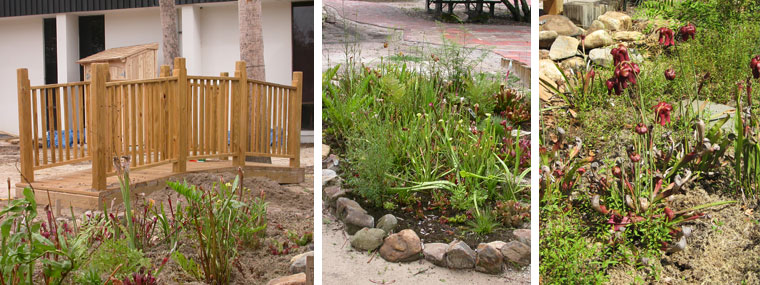
Creating Rain Gardens
By Lynn Barber / Published Nov 2015

Creating a rain garden is an easy way to make good use of a low area in your landscape or at the bottom of a downspout where water accumulates. Rain gardens are shallow depressions in the ground (any shape or size) that can perform several functions. They capture stormwater runoff from roofs, driveways, and other impervious surfaces and allow this runoff to percolate through the soil. Rain gardens decrease flooding, reduce erosion, and attract beneficial insects and wildlife. They also filter runoff, which would otherwise carry pollutants (oil, fertilizer, chemicals, pet waste, grass clippings, etc.) down storm drains and ultimately into bodies of water, resulting in algae bloom and ultimately fish kill. If you have been to the beach during red tide, you have experienced firsthand the impact of this pollution. Rain gardens are a habitat for butterflies, pollinators, other beneficial insects, and birds. By increasing the amount of water that can filter into the ground, rain gardens also recharge your local aquifer.
Rain gardens are a beautiful landscape addition that can be planted with carnivorous plants as we have done in the Bette S. Walker Discovery Garden, University of Florida Extension Hillsborough County. The plant selections we made consisted of Pitcher plants (Sarracenia), Sundews (Drosera) and Southeastern butterworts (Pinguicula). However, there are many plants other than carnivorous ones that like ‘wet feet’ and are drought-tolerant for those times we don’t get much rain. Some examples include: Tickseed, Milkweed, African iris, Louisiana iris, Blue flag iris, Canna lily, Swamp sunflower, Cinnamon fern, Shrimp plant, Bald cypress, River birch, Beautyberry, Dwarf palmetto, Walter’s viburnum, Swamp hibiscus, Florida gamma grass, River oats, and Muhly grass.
There are two things you should do before you purchase plants for your rain garden. The first is to check the Florida-Friendly Landscaping™ Guide to Plant Selection & Landscape Design to determine which plants are suitable for your part of the state, north, central or south. You can access this Guide at: fyn.ifas.ufl.edu/pdf/FYN_Plant_Selection_Guide_v090110.pdf. This resource contains photos of the plants, information about their growth rate, height and spread, soil pH needed, soil texture and soil moisture, drought and salt tolerance, light range and light optimum, wildlife attracted, and whether native or non-native. The second thing you should do is determine the existing site conditions. These conditions include: sun or shade, moist or well-drained soil, mature height and width of the plants you have selected and soil texture. Rain gardens installed in sandy soils only hold water for a few hours.
The first step in building a rain garden is to determine its size and placement, which should be at least 10 feet from your foundation, in full sun, not within 25 feet of a septic tank or well, away from tree roots, in an existing low area, which quickly drains after a heavy rain and within 30 feet of a water source. The second step in rain garden construction is to call 811, Sunshine State One Call of Florida, Inc. for underground utility marking. After the utilities have been marked, you can lay out a garden hose to create the shape and size you want and then dig the rain garden.
Lynn Barber, Agent
University of Florida/IFAS Extension, Hillsborough County
Lynn Barber, Agent, University of Florida/IFAS Extension, Hillsborough County, is responsible for educating residents on the nine principles of the Florida Friendly LandscapingTM program. These principles include right plant right place, water efficiently, fertilize appropriately, mulch, attract wildlife, manage yard pests responsibly, recycle, reduce stormwater runoff, and protect the waterfront. Barber is past president of the Florida Association of Natural Resource Extension Professionals and has received numerous awards for programming, publications, and television and radio segments. As a Master Gardener, she has given back thousands of hours in environmental horticulture education to the community.
The larger the garden, the larger the plant diversity and more maintenance that may be required. Maintenance involved includes watering plants until they become established (30–60 days or so), weeding and spreading mulch or sphagnum moss to top dress the rain garden. Using mulch or sphagnum moss will decrease weed growth, compaction, and regulate the soil temperature and retain moisture. We have refurbished our rain garden twice, and each time it has become more beautiful!
This is an overview of the steps needed to create your rain garden. For more detailed information, please see Fact Sheet: Rain Gardens by Marina D’Abreau, Ed.D., our former Horticulture Agent at: hillsborough.ifas.ufl.edu/documents/pdf/lawn_garden/factsheets/Rain_Gardens.pdf, Rain Gardens: Plant Selection and Maintenance by Annemarie Post, Extension Agent, Sarasota County UF/IFAS Extension Service, sarasota.ifas.ufl.edu/FYN/Pubs/AP-04102010-004_Rain_Gardens_Plant_Selection_Maintenance.pdf and Rain Gardens, A Manual for Central Florida Residents by Marina D’Abreau, from which this article was adapted.
As always, follow the landscape or architectural control procedures in your deed restrictions before making changes. For more information about the nine principles of the Florida-Friendly Landscaping™ Program or for assistance with gardening related questions, contact your local county Extension office and/or visit the University of Florida website: solutionsforyourlife.com or edis.ifas.ufl.edu.


